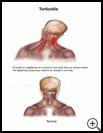
Torticollis
________________________________________________________________________
KEY POINTS
- Torticollis is tightening of a muscle in your neck that you cannot control. The tightening causes your head to tilt, usually to one side.
- Treatments may include wearing a soft orthopedic collar, physical therapy, heat therapy, medicines, traction, or surgery.
________________________________________________________________________
What is torticollis?
Torticollis or "wry neck" is a tightening of a muscle in your neck that you cannot control. The tightening causes your head to tilt, usually to one side.
What is the cause?
Torticollis has many different causes:
- Congenital muscular torticollis, which may be caused by the neck muscle being stretched too much when a baby is born
- Spasmodic torticollis, which usually develops in middle-aged adults and is more common in women. It may cause the muscles around your neck to spasm off and on or all the time.
- A neck injury or spinal tumor
- Eyes that point in different directions (strabismus), which may cause you to tilt your head to get a clearer image
- Other problems that affect the neck, such as arthritis or a herniated disk. Disks are rubbery cushions between the bones of the spine.
Some medicines can cause torticollis.
What are the symptoms of torticollis?
Depending on the cause, symptoms may start quickly, or may start gradually and get worse over months or years. Symptoms may include:
- A crooked neck that you can’t straighten
- Constant and severe neck pain
- Muscle spasms on one side of your neck
How is torticollis diagnosed?
Your healthcare provider will ask about your symptoms and medical history and examine you. Tests may include:
- X-rays
- CT scan, which uses X-rays and a computer to show detailed pictures of the neck
- MRI, which uses a strong magnetic field and radio waves to show detailed pictures of the neck
How is it treated?
Treatment depends on the cause.
If medicine is causing your symptoms, your provider may change your medicine. Treating neck injuries, arthritis, or other problems may also help the torticollis.
Your healthcare provider may prescribe a physical therapy exercise program.
Botox injections may be used to relieve muscle spasms. Botox injections wear off in about 3 months, so you usually need to repeat the injections. Other medicines may also be prescribed to reduce or stop the muscle spasms and pain.
Other treatments include wearing a soft orthopedic collar, traction, heat therapy, or rarely, surgery.
How can I take care of myself?
Follow the full course of treatment prescribed by your healthcare provider. In addition:
- Put an ice pack, gel pack, or package of frozen vegetables, wrapped in a cloth on the painful area every 3 to 4 hours for up to 20 minutes at a time.
- Take an anti-inflammatory medicine, such as ibuprofen, or other medicine as directed by your healthcare provider. Nonsteroidal anti-inflammatory medicines (NSAIDs), such as ibuprofen, may cause stomach bleeding and other problems. These risks increase with age. Read the label and take as directed. Unless recommended by your healthcare provider, you should not take this medicine for more than 10 days.
- Put moist heat on the sore area for 10 to 15 minutes before you do warm-up and stretching exercises. Moist heat may help relax your muscles. Moist heat includes heat patches or moist heating pads that you can buy at most drugstores, a warm wet washcloth, or a hot shower. Put a hot water bottle or electric heating pad on your back. Cover the hot water bottle with a towel or set the heating pad on low. To prevent burns to your skin, follow directions on the package and do not lie on any type of hot pad. Don’t use heat if you have swelling.
Ask your healthcare provider:
- How and when you will get your test results
- How long it will take to recover from this condition
- If there are activities you should avoid and when you can return to your normal activities
- How to take care of yourself at home
- What symptoms or problems you should watch for and what to do if you have them
Make sure you know when you should come back for a checkup. Keep all appointments for provider visits or tests.

